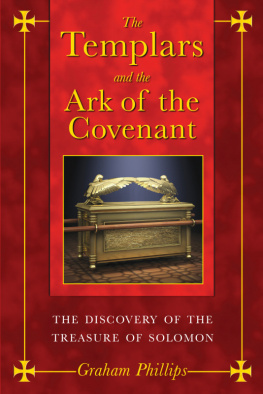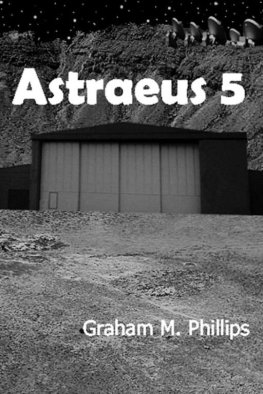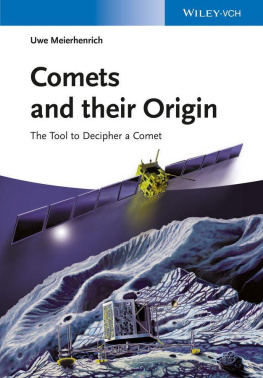THE
END OF EDEN
In an extraordinary tour de force, Graham Phillips pinpoints a major mystery with important implications for our understanding of the remote pastand the origins of ancient religion. Painstakingly researched and soberlypresentedbut never less than eminently readablethis book provides ananswer so explosive that it should instantly ensure itself a place among thegreat revelations of history.
LYNN PICKNETT AND CLIVE PRINCE, AUTHORS OF
THE TEMPLAR REVELATION AND THE SION REVELATION
This is a very exciting and important book, which suggests a highly plausible reason why organized cruelty seems to have come into the world at a surprisingly late date. I believe Graham Phillipss ideas are going to cause widespread controversy.
COLIN WILSON, AUTHOR OF THE OUTSIDER AND
ATLANTIS AND THE KINGDOM OF THE NEANDERTHALS: 100,000 YEARS OF LOST HISTORY
THE
END OF EDEN
The Comet That Changed Civilization
GRAHAM PHILLIPS

Bear & Company
Rochester, Vermont
In loving memory of Marion Sunderland
Acknowledgments
The author would like to thank the following people for their invaluable help: Professor Joseph Carter, Michael Dyer, and Dr. Philip Payne, without whose help this book would not have been possible, and Louise Simkiss for her invaluable research. And all at Inner Traditions International: Jeanie Levitan, Anne Dillon, Jon Graham, Kelly Bowen, Patricia Rydle, Rob Meadows, and Cynthia Ryan. I would also like to offer a very special thanks to Debbie Cartwright for her continued and invaluable encouragement, and Yvan Cartwright for his computer support and compiling the index.
For more information about Graham Phillips, his books, and his research, please visit his Web site at www.grahamphillips.net.
Contents
AUTHORS NOTE CONCERNING
THE DATING OF HISTORICAL EVENTS
Our modern Western calendar begins the first year at what is thought to have been the birth of Christ, and is referred to by the Latin term anno domini, meaning in the year of our Lord. It is abbreviated by the letters AD, although this prefix is usually omitted. The years before the time of Christs estimated birth work backward and are suffixed with the abbreviation BC meaning before Christ. Unlike AD dates, the higher the number of the BC date, the further it is back in time. Because the initials AD and BC are a Christian dating system, many modern scholars use the alternative abbreviations CE, short for common era, instead of AD, and BCE, short for before common era, instead of BC. Because the layperson is generally more familiar with the terms AD and BC however, these are the abbreviations that are used in this book.

Stonehenge and the Megalithic Culture
STONEHENGE, IN SOUTHERN ENGLAND , is not only one of the worlds most famous ancient monuments; it is also one of the most enigmatic. Just why it was built is one of historys most intriguing mysteries. An even greater mystery, however, is: What happened to the people who built it?
The Stonehenge builders are known as the megalithic people, a prehistoric culture that existed in Britain, Ireland, and part of northern France between approximately fifty-five hundred and thirty-five hundred years ago. We have no idea what they called themselves, as they left no written records; the name megalithic used today is derived from the word megalith, meaning a large, shaped stone, and refers to the monuments these people left behind. These monuments include single standing stones, rows of such stones, and stone circles, of which Stonehenge is just one of many. The megalithic people also built earthworks of considerable size, such as chambered mounds, artificial hills, and many examples of a circular ditch and embankment known as a henge. It is from such an earthwork surrounding Stonehenge that the monument gets its name. As the megalithic people had no form of writing, the purpose of these monuments remains a mystery. What can be said for certain, however, is that they were a remarkable people; they built their monuments with nothing more than Stone Age tools. Stonehenge alone is an astonishing feat of prehistoric engineering.
Stonehenge originally comprised well over a hundred stones, up to 22 feet high and weighing up to 45 tons. They were cut from solid rock, shaped, and then neatly trimmed with simple stone axes and picks made from antlers. These huge stones were then dragged from where they were quarried for mile after mile without the help of draft animals, such as horses or oxen, by a people who had not invented the wheel. Then, in some way that is not fully understood, the builders planted and hauled the stones into upright positions and, more astonishing still, without cranes or machines of any kind, they managed to raise and position thirty 6-ton blocks on top of 13-foot-high stones to form a continuous ring of adjoining arches almost 350 feet around. And all this is only a small part of the full story of the construction of Stonehenge.
Stonehenge is the most famous megalithic monument, but it is just one of hundreds of such stone circles these people erectedand it is far from the biggest. Twenty miles to the north of Stonehenge in the village of Avebury, there is a stone circle so large that it encompasses much of the village. Stonehenges outer circle of stones is around 110 feet in diameter, but the Avebury stone circle measures well over 1,000 feet across. The monument originally consisted of almost two hundred stones, many as large as those at Stonehenge, and its outer henge earthwork is more than 20 feet high and has a circumference of three quarters of a mile. The megalithic people built artificial mounds around Stonehenge, and some of these impressive hillocks are over 10 feet high and as much as 50 feet across, but close to Avebury there is a megalithic mound that dwarfs them all. Known as Silbury Hill, it is a staggering 130 feet high and covers an area of five and a half acres. It is estimated that moving the half-million tons of rubble to build this mound alone would have taken as much as eighteen million man-hours. The term man-hours, however, is almost certainly misleading. It has also been estimated that for Silbury Hill to have been completed in the fifteen years archaeologists believe it took to build, a large percentage of the population of south-central England would need to have worked on the project: this would clearly have necessitated women, and perhaps even children, working on it too.
Stonehenge and Avebury are just two of hundreds of such megalithic complexes that were constructed all over Britain, Ireland, and northern France, which continued to be built and used for a period spanning two thousand years. The monuments of the megalithic people may well have served some religious purpose, as did the great cathedrals of the European Middle Ages, or some may have been constructed to honor the dead, as were the pyramids of ancient Egypt, or perhaps they were built for some other reason entirely. Whatever their true purpose, the megalithic monuments were astonishing achievements. Taking into consideration that the estimated population of the entire British Isles at the time was less than a million, and bearing in mind the simple Stone Age tools they employed, monuments such as Stonehenge and Avebury were as spectacular accomplishments as anything from medieval Christendom or ancient Egypt.
These megalithic monuments were constructed not only throughout mainland England, Scotland, and Wales but also on the coastal islands, over the Irish Sea in Ireland, and even across the English Channel in northern France. Although the communities of people who built them were separated by hundreds of miles, the similarity of their constructions over many centuries is clear evidence that they had, and continued to have, a common culture. Moreover, they were arguably a unified civilization. Although they did not build cities, but rather continued to live in simple farming communities, their monumental construction projects, occurring simultaneously throughout what are today five separate countries, indicate social cohesion, an efficient communication network, central administration, and considerable organizational skills: all the features of a civilization. And if the megalithic people were a civilization, then they were one of the worlds first. Their oldest surviving structures date from around fifty-five hundred years ago, and they predate the pyramids of Egypt by almost a millennium.
Next page




![ZHyul Vern - Off on a Comet [Hector Servadac]](/uploads/posts/book/834994/thumbs/zhyul-vern-off-on-a-comet-hector-servadac.jpg)





